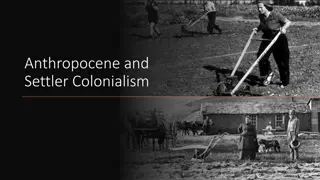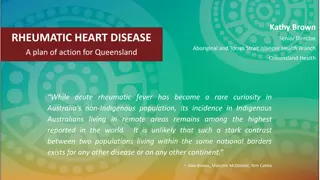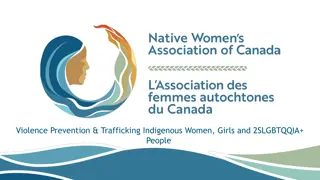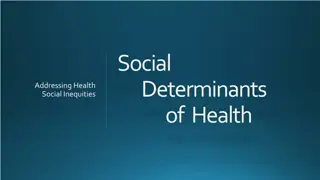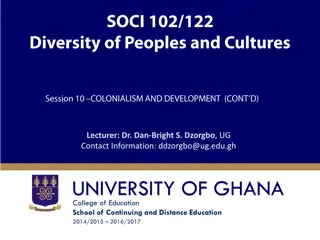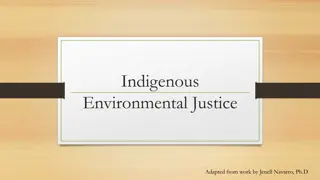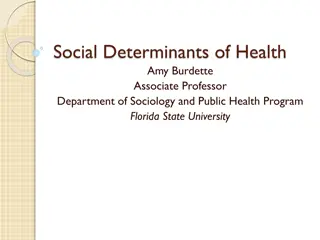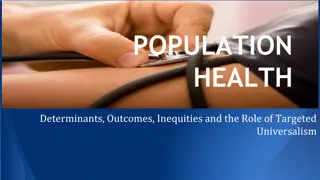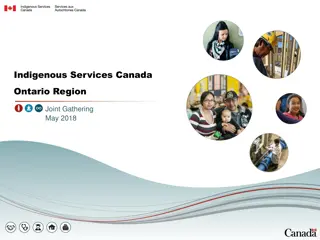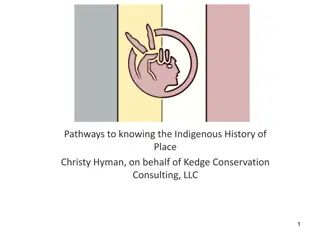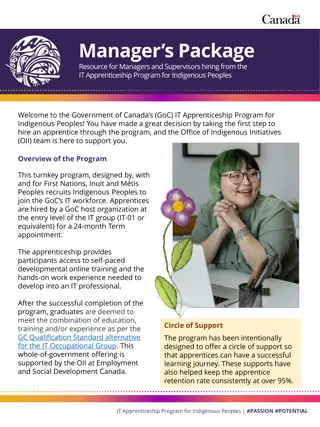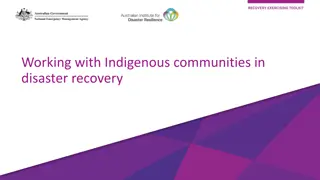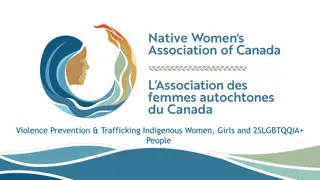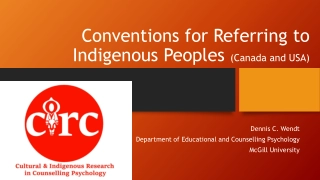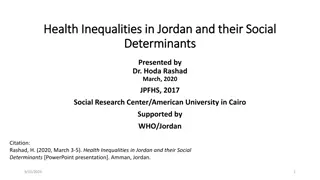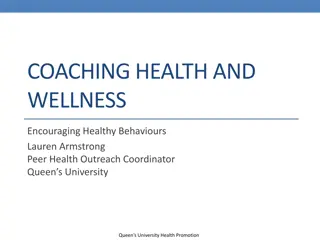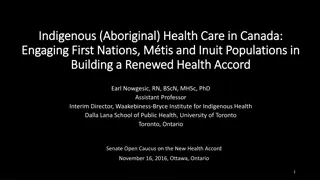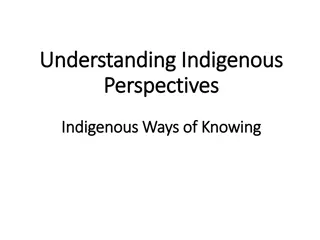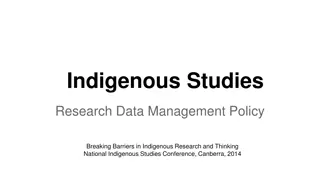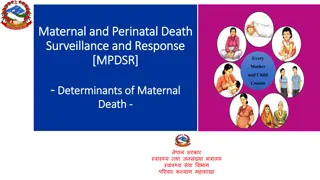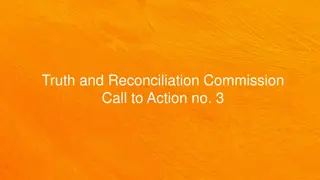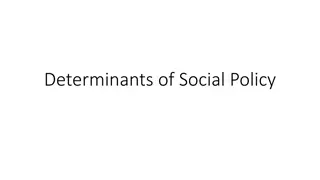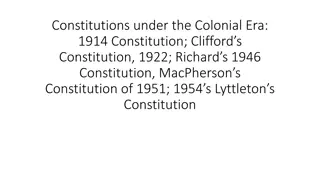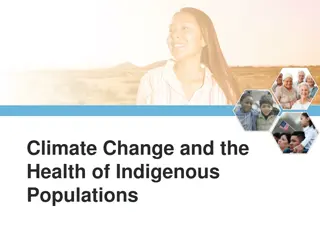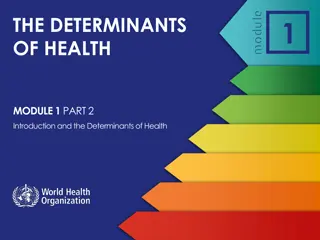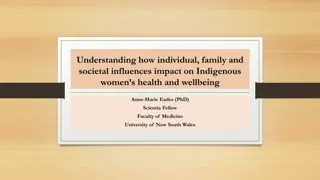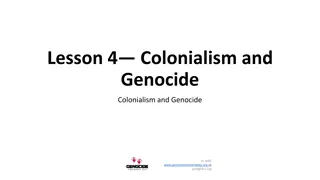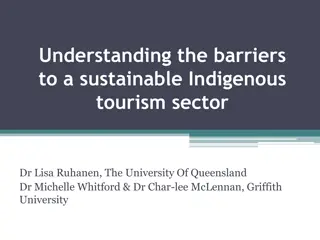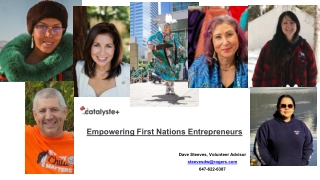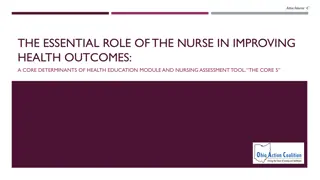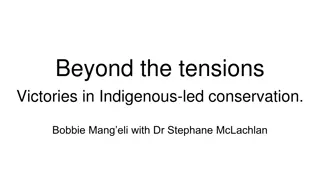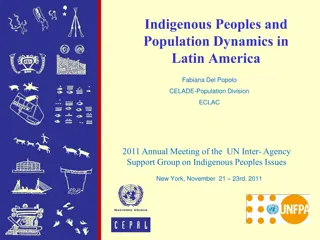Understanding Indigenous Child Health in Canada: Impact of Colonialism, Social Determinants, and Medical Conditions
Explore the lasting impacts of colonialism on Indigenous child health in Canada, focusing on social determinants leading to poorer outcomes, disproportionate medical conditions affecting pediatric patients, and the need for culturally appropriate healthcare. Topics cover poverty, education, common conditions like dental caries and respiratory illness, as well as skin and soft tissue infections.
Download Presentation

Please find below an Image/Link to download the presentation.
The content on the website is provided AS IS for your information and personal use only. It may not be sold, licensed, or shared on other websites without obtaining consent from the author. Download presentation by click this link. If you encounter any issues during the download, it is possible that the publisher has removed the file from their server.
E N D
Presentation Transcript
Indigenous Child Health in Canada: Part II Nikita-Kiran Singh with Dr. Lola Baydala and Sherri Di Lallo Music: Grandmother s Song by Aaron Letendre
Learning Objectives 1) To discuss the lasting impacts colonialism has had on Indigenous health today. 2) To identify the social determinants that have given rise to poorer health outcomes among Indigenous families. 3) To identify and understand why certain medical conditions disproportionately affect Indigenous pediatric patients. 4) To appreciate the importance of culturally appropriate healthcare interventions for Indigenous children and youth. Nikita-Kiran Singh with Dr. Lola Baydala and Sherri Di Lallo
Linking History to Today Nikita-Kiran Singh with Dr. Lola Baydala and Sherri Di Lallo
Poverty Race Education Social Determinants of Health Housing Social exclusion Gender equity Nikita-Kiran Singh with Dr. Lola Baydala and Sherri Di Lallo
Common Conditions Nikita-Kiran Singh with Dr. Lola Baydala and Sherri Di Lallo
Dental Caries Early childhood caries (<6 years old) Usually Streptococcus mutans Risk factors: Diet high in carbohydrates Host susceptibility Bottle-feeding Sequelae: Pain Growth restriction Difficulty learning in class Treatment Community fluoride programs Risk reduction: Prenatal oral health screening Breast-feeding Access to education re: oral hygiene Nikita-Kiran Singh with Dr. Lola Baydala and Sherri Di Lallo
Respiratory Illness Risk factors: Poor ventilation Overcrowding Asthma Bronchitis Tuberculosis RSV palivizumab prophylaxis if: Born <36 weeks gestation <6 months age at beginning of RSV season Would require air transport to hospital Image: Library and Archives Canada Nikita-Kiran Singh with Dr. Lola Baydala and Sherri Di Lallo
Skin and Soft Tissue Infections Scabies Mite Sarcoptes scabei Linear burrows Pruritis Sometimes vesicles / pustules Community-acquired methicillin- resistant Staphylococcus aureus (CA- MRSA) Risk factors: overcrowding, lack of potable water Risk reduction: clean water, antimicrobial stewardship, hand hygiene ancona.diagnostica.izsum <a href="http://www.flickr.com/photos/136941790@N03/22635992060">Sarcoptes scabiei</a> via <a href="http://photopin.com">photopin</a> <a href="https://creativecommons.org/licenses/by/2.0/">(license)</a> Sarcoptes scabei Nikita-Kiran Singh with Dr. Lola Baydala and Sherri Di Lallo
Diabetes and Obesity Diabetes Mellitus Risk Factors Obesity Physical inactivity May not have school programs available May be unsafe to play outdoors Food insecurity Lack of nutritional options Financial barriers Family history First or second degree relatives Screening Screening tests Fasting blood glucose Random glucose Oral glucose tolerance test Screen for diabetes if: BMI > 85thpercentile and 10 years old with at least one of: Sedentary lifestyle, maternal gestational diabetes history, family history, acanthosis nigricans, dyslipidemia, hypertension, polycystic ovarian syndrome Nikita-Kiran Singh with Dr. Lola Baydala and Sherri Di Lallo
Substance Use and Addictions Nikita-Kiran Singh with Dr. Lola Baydala and Sherri Di Lallo
Substance Use and Addictions Alcohol Higher rates of both drinking and non- drinking in Indigenous communities Fetal alcohol spectrum disorder Short palpebral fissures Flattened facial features Smooth philtrum Neurodevelopmental, attention, and learning challenges Early identification early intervention Tobacco Difference between ceremonial and recreational uses Smoke exposure increases risk of: Lower respiratory infections Otitis media and hearing loss Meningococcal disease Lung cancer Smoking cessation strategies should affirm traditional use / address cultural context Nicotine replacement therapy is covered by non-insured health benefits (NIHB) Nikita-Kiran Singh with Dr. Lola Baydala and Sherri Di Lallo
Substance Use and Addictions Inhalant Use Short-term euphoric state Long-term irreversible neurological effects Culturally appropriate treatment programs most effective Opioids First nations communities more likely to be prescribed opioid medications and to die by overdose Need to redress inappropriate opioid prescribing Naloxone reversal agent Need to increase accessibility Nikita-Kiran Singh with Dr. Lola Baydala and Sherri Di Lallo
Mental Health and Suicide Suicide and Depression Suicide rate 4-5 times higher than in non-Indigenous youth States of emergency have been declared Critical to address identity and intergenerational trauma Affirming relationships with family and elders Risk factors for suicide in adolescents: Depression Substance use History of self-harm Impulsivity Social / family factors Remote location Lack of connectivity to psychosocial support Nikita-Kiran Singh with Dr. Lola Baydala and Sherri Di Lallo
Injury Prevention Mechanisms of Unintentional Injury Motor vehicle collisions Drowning Fires Poisonings Animal bites Anticipatory Guidance Injury prevention measures: Child restraints and seatbelts Safety helmets Safe disposal of cigarettes Child-proof storage of poisons Supervising children in water Nikita-Kiran Singh with Dr. Lola Baydala and Sherri Di Lallo
Conclusion Nikita-Kiran Singh with Dr. Lola Baydala and Sherri Di Lallo
Conclusion 1) The impacts of colonialism on Indigenous health include reduced life expectancy, higher disease burden, and systemic barriers such as racism and discrimination which impede access to quality care. 2) Poverty, overcrowding, limited access to health care services, and food insecurity are social determinants that contribute to health disparities in Indigenous communities. 3) Medical conditions that disproportionately affect Indigenous children and youth include dental caries, respiratory illness, skin and soft-tissue infections, diabetes, substance use, suicide, and unintentional injury. Nikita-Kiran Singh with Dr. Lola Baydala and Sherri Di Lallo
Conclusion 4) The higher prevalence of addiction and suicide among Indigenous communities reflects the ongoing impact of intergenerational trauma. 5) Culturally appropriate healthcare interventions that utilize the strengths and resilience of Indigenous communities are crucial to addressing the underlying causes of trauma. References included in script on PedsCases.com. Nikita-Kiran Singh with Dr. Lola Baydala and Sherri Di Lallo
Thank you! Music: Grandmother s Song by Aaron Letendre Nikita-Kiran Singh with Dr. Lola Baydala and Sherri Di Lallo


